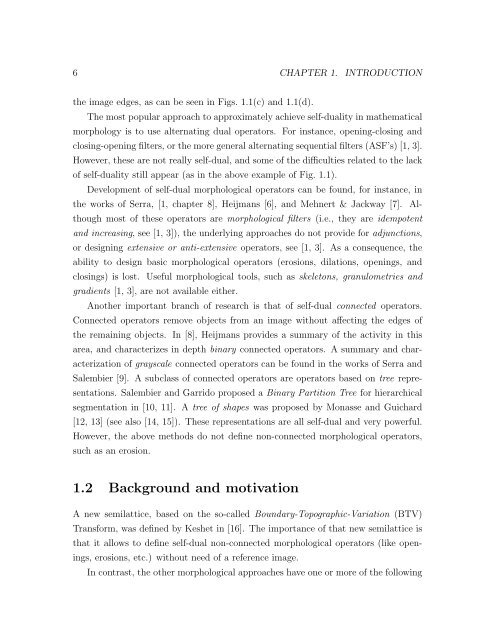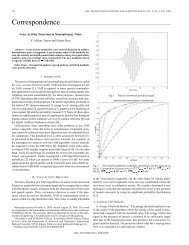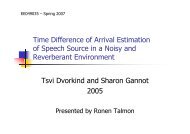Thesis (PDF) - Signal & Image Processing Lab
Thesis (PDF) - Signal & Image Processing Lab
Thesis (PDF) - Signal & Image Processing Lab
Create successful ePaper yourself
Turn your PDF publications into a flip-book with our unique Google optimized e-Paper software.
6 CHAPTER 1. INTRODUCTION<br />
the image edges, as can be seen in Figs. 1.1(c) and 1.1(d).<br />
The most popular approach to approximately achieve self-duality in mathematical<br />
morphology is to use alternating dual operators. For instance, opening-closing and<br />
closing-opening filters, or the more general alternating sequential filters (ASF’s) [1, 3].<br />
However, these are not really self-dual, and some of the difficulties related to the lack<br />
of self-duality still appear (as in the above example of Fig. 1.1).<br />
Development of self-dual morphological operators can be found, for instance, in<br />
the works of Serra, [1, chapter 8], Heijmans [6], and Mehnert & Jackway [7]. Al-<br />
though most of these operators are morphological filters (i.e., they are idempotent<br />
and increasing, see [1, 3]), the underlying approaches do not provide for adjunctions,<br />
or designing extensive or anti-extensive operators, see [1, 3]. As a consequence, the<br />
ability to design basic morphological operators (erosions, dilations, openings, and<br />
closings) is lost. Useful morphological tools, such as skeletons, granulometries and<br />
gradients [1, 3], are not available either.<br />
Another important branch of research is that of self-dual connected operators.<br />
Connected operators remove objects from an image without affecting the edges of<br />
the remaining objects. In [8], Heijmans provides a summary of the activity in this<br />
area, and characterizes in depth binary connected operators. A summary and char-<br />
acterization of grayscale connected operators can be found in the works of Serra and<br />
Salembier [9]. A subclass of connected operators are operators based on tree repre-<br />
sentations. Salembier and Garrido proposed a Binary Partition Tree for hierarchical<br />
segmentation in [10, 11]. A tree of shapes was proposed by Monasse and Guichard<br />
[12, 13] (see also [14, 15]). These representations are all self-dual and very powerful.<br />
However, the above methods do not define non-connected morphological operators,<br />
such as an erosion.<br />
1.2 Background and motivation<br />
A new semilattice, based on the so-called Boundary-Topographic-Variation (BTV)<br />
Transform, was defined by Keshet in [16]. The importance of that new semilattice is<br />
that it allows to define self-dual non-connected morphological operators (like open-<br />
ings, erosions, etc.) without need of a reference image.<br />
In contrast, the other morphological approaches have one or more of the following
















